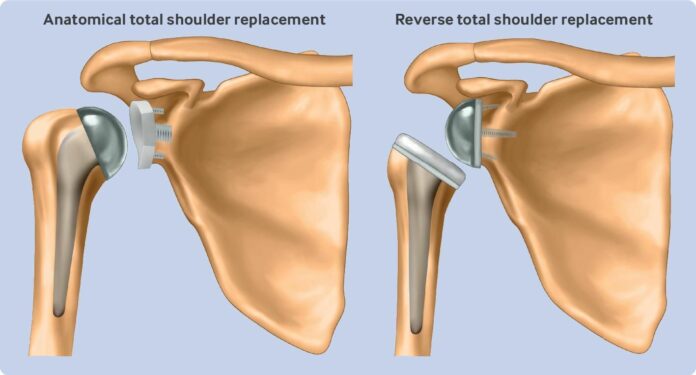Shoulder replacement surgery is an effective treatment option for end-stage shoulder arthritis and is rising in incidence internationally. Traditional anatomical total shoulder replacements (TSR) have long been considered the gold standard for treating patients with OA and intact rotator cuff tendons. However, reverse total shoulder replacement (RTSR), initially developed for rotator cuff arthropathy, has expanded globally across different surgical indications.
This shift in practice is growing despite a lack of supporting evidence. The research, led by the University of Oxford and involving researchers from the University of Bristol, aims to answer a national research priority by comparing the risk-benefit and costs associated with RTSR and TSR in patients having elective primary shoulder replacement for osteoarthritis.
Scientists found that reverse total shoulder replacements (RTSR) provide similar long-term outcomes to traditional anatomical total shoulder replacements (TSR) for patients aged 60 years or older with osteoarthritis (OA) and intact rotator cuff tendons.
Dr Adrian Sayers, Senior Research Fellow at Bristol Medical School: Translational Health Sciences (THS) and co-author, added: “This work shows the tremendous potential of routinely collected data in promptly answering questions that are important to patients. It is reassuring for patients and surgeons to know that either reverse or traditional anatomic shoulder replacement for osteoarthritis is a safe and effective. This question was asked and answered in a fraction of the time and cost of conventional randomized clinical studies.”
The research team conducted a population-based cohort analysis using linked data from the NHS Hospital Episode Statistics for England and the National Joint Registry. The study comprised over 12,000 patients with undamaged rotator cuff tendons who received RTSR or TSR for OA between 2012 and 2020 and were 60 or older.
To compare the two types of treatments, the researchers looked at patient outcomes for revision surgery, significant adverse events, reoperations, length of hospital stay, and lifetime expenditures to the healthcare system.
The findings revealed that while TSR had a higher risk of revision surgery in the first three years after surgery, there was no significant difference in the longer term, and both procedures were equally safe for patients.
Epaminondas Markos Valsamis, NIHR Doctoral Research Fellow at the University of Oxford and lead author explained, “By the end of the study period, we found no ‘clinically important’ difference in any outcome. This reassures patients and surgeons that RTSR is an acceptable alternative for this patient group, and we found no evidence to change the growing surgical trend of offering RSTR to them.”
Additional study is required to explore functional outcomes and to inform a full cost-effectiveness comparison of RTSR and TSR. This study offers crucial insights that can help guide clinical practice by supporting patients and surgeons in making more informed decisions about the best treatment options to optimize patient outcomes.
Journal Reference:
- Epaminondas Markos Valsamis, Albert Prats-Uribe et al. Reverse total shoulder replacement versus anatomical total shoulder replacement for osteoarthritis: population-based cohort study using data from the National Joint Registry and Hospital Episode Statistics for England. BMJ. DOI: 10.1136/bmj-2023-077939
